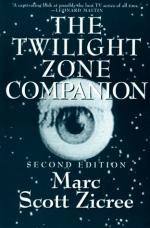|
This section contains 527 words (approx. 2 pages at 400 words per page) |

|
The Twilight Zone Companion Summary & Study Guide Description
The Twilight Zone Companion Summary & Study Guide includes comprehensive information and analysis to help you understand the book. This study guide contains the following sections:
This detailed literature summary also contains Topics for Discussion and a Free Quiz on The Twilight Zone Companion by Marc Scott Zicree.
"The Twilight Zone" is by far one of the most innovative and iconic television series of all time. Its creator and narrator, Rod Serling, managed to do what had never been done before when he combined wild imagination and horror, fantasy and science fiction to create a serial featuring the era's most illustrious guest stars involved in outrageous scenarios.
"The Twilight Zone Companion" is just what the name implies: a companion guide to the five seasons of the show, from inception to legacy. Marc Scott Zicree is a well known expert on the topic and the extent of knowledge and hard work shows in the outcome. Zicree not only offers synopses of each episode but also refers to comments by Serling via news clips, interviews, and the memories of colleagues, friends, and family. The addition of outside material makes the book sing and the insight offered by those working on the show is invaluable. The most notable resources include Carolyn Serling, Rod's wife; Bob Serling, Rod's older brother; producers Buck Houghton and Bill Self; Bert Granet, the show's original backer; writers Charles Beaumont and Richard Matheson; and George T. Clemens, long time Director of Photography.
Each episode is detailed in such a way that all of the major players are identified - director, writer, producer, crew, and stars - as well as a synopsis of the show. There are often accompanying stories or comments made by Serling or one of the other people involved in the creation of that particular episode.
"The Twilight Zone Companion" also details Serling's early years as an Army paratrooper and boxer before turning to writing in college. Although many people remember Serling only for "The Twilight Zone" and perhaps "Night Gallery," Zicree shows that Serling had a substantial career both before and after the show's five year run.
The book provides a glimpse into the relationships Serling maintained outside the show, including those with his wife and children. Zicree also manages to detail many aspects of Serling's persona. Serling was known as a man so enthusiastic and full of energy that by today's standards, the creative genius might be considered hyperactive. Serling was a die hard chain smoker which most likely led to his untimely demise at age 50 from a heart attack after a grueling ten hour coronary bypass surgery. Buck Houghton recalls that Serling had no patience. The man was not impatient; he simply had no patience for long meetings or debates. Serling simply wanted to get it done and move on to the next thing. The same behaviors applied to his writing. Serling was able to create flawless scripts at the speed of light, often writing while the show was being shot.
As one might expect, the frenzied pace caused Serling to burn out after three seasons. The show's fourth season began to show wear and tear as well as the absence of Serling on a daily basis. The fifth season convinced Serling that it was time to put the show to bed.
Although Rod Serling would go on to other successful projects, none quite matched the brilliance and innovative quality found in "The Twilight Zone."
Read more from the Study Guide
|
This section contains 527 words (approx. 2 pages at 400 words per page) |

|



